10.2.1 Assessing breastfeeding
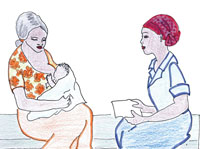
Assessing breastfeeding requires careful observation (Figure 10.3). Ask the mother when she last fed her infant and then, when the infant is ready to feed again, you should help the mother to feel relaxed and comfortable.
ASK: Has the infant breastfed in the previous hour?
If the infant has already been fed in the last hour, ask the mother to wait and tell you when the infant is willing to feed again. In the meantime, complete the assessment by checking the infant’s immunization status. You may also decide to begin any treatment that the infant needs, such as giving an antibiotic for local bacterial infection or ORS solution for some dehydration.
If the infant has not fed in the previous hour, he or she may be willing to breastfeed. Ask the mother to put her infant to the breast. Observe a whole breastfeed if possible, or observe for at least four minutes.
Sit quietly and watch the infant breastfeed.
LOOK: Is the infant well positioned?
The four signs of good positioning are:
- The infant’s body is straight
- The infant’s head and body are facing the breast
- The infant’s body is close to the mother’s
- The mother is supporting the infant’s whole body.
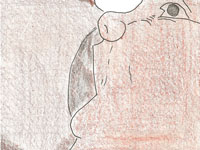
LOOK: Is the infant able to attach?
The four signs of good attachment (see Figure 10.4) are:
- The infant’s chin is touching the breast (or is very close)
- The infant’s mouth is wide open
- The lower lip is turned outward
- More areola is visible above than below the infant’s mouth (the areola is the dark area of the breast around the nipple).
If all of these four signs are present, the infant has good attachment. This is also illustrated in Figure 10.5.
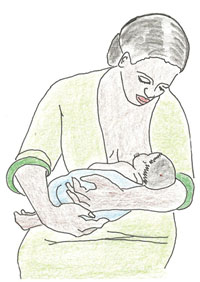
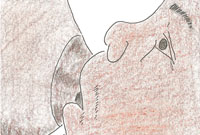
If attachment is not good (see Figure 10.6), you may see:
- The infant’s chin is not touching the breast
- The mouth is not wide open with the lips pushed forward
- The lower lip is turned in, or
- More areola (or an equal amount) is visible below the infant’s mouth than above it.
If you see any of these signs of poor attachment, the infant is not well attached. This is also illustrated in Figure 10.7.
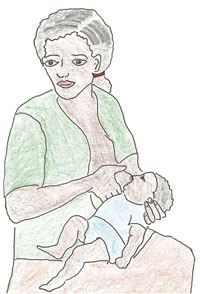
If a very sick infant cannot take the nipple into his mouth and keep it there to suck, he has no attachment at all. He is not able to breastfeed at all.
You can support a breastfeeding mother to overcome attachment problems.
If an infant is not well attached, the results may be pain and damage to the mother’s nipples. Or the infant may not remove breastmilk effectively, which may cause engorgement (swelling) of the breast. The infant may be unsatisfied after breastfeeds and want to feed very often or for a very long time. The infant may get too little milk and not gain weight, or the breastmilk may dry up. All these problems may improve if attachment can be improved.
LOOK: Is the infant suckling effectively?
The infant is suckling effectively if he suckles with slow deep sucks and sometimes pauses. You may see or hear the infant swallowing. If you can observe how the breastfeed finishes, look for signs that the infant is satisfied. If satisfied, the infant releases the breast spontaneously (that is, the mother does not cause the infant to stop breastfeeding in any way). The infant appears relaxed, sleepy, and loses interest in the breast.
An infant is not suckling effectively if he is taking only rapid, shallow sucks. You may also see in-drawing (inward movement) of the cheeks. You do not see or hear swallowing. The infant is not satisfied at the end of the feed, and may be restless. He may cry or try to suckle again, or continue to breastfeed for a long time.
An infant who is not suckling at all is not able to suck breastmilk into his mouth and swallow. Therefore, he is not able to breastfeed at all.
If a blocked nose seems to interfere with breastfeeding, you should clear the infant’s nose. Then check again whether the infant can suckle more effectively.
LOOK for ulcers or white patches in the mouth (thrush)
Look inside the mouth at the tongue and inside of the cheek. Thrush looks like milk curds on the inside of the cheek, or a thick white coating of the tongue. Try to wipe the white off and look to see if this leaves bleeding spots or a raw area.
-
What are the signs of good attachment?
-
There are four ways that you can tell if an infant is attached well during a breastfeed. The infant’s chin should either touch or be very close to the mother’s breast and the infant’s mouth should be wide open, with the lower lip turned outwards. You should see if there is more areola visible above than below the mouth. If the infant’s body is twisted away from the mother, there is unlikely to be good attachment.
10.2 Assess breastfeeding
